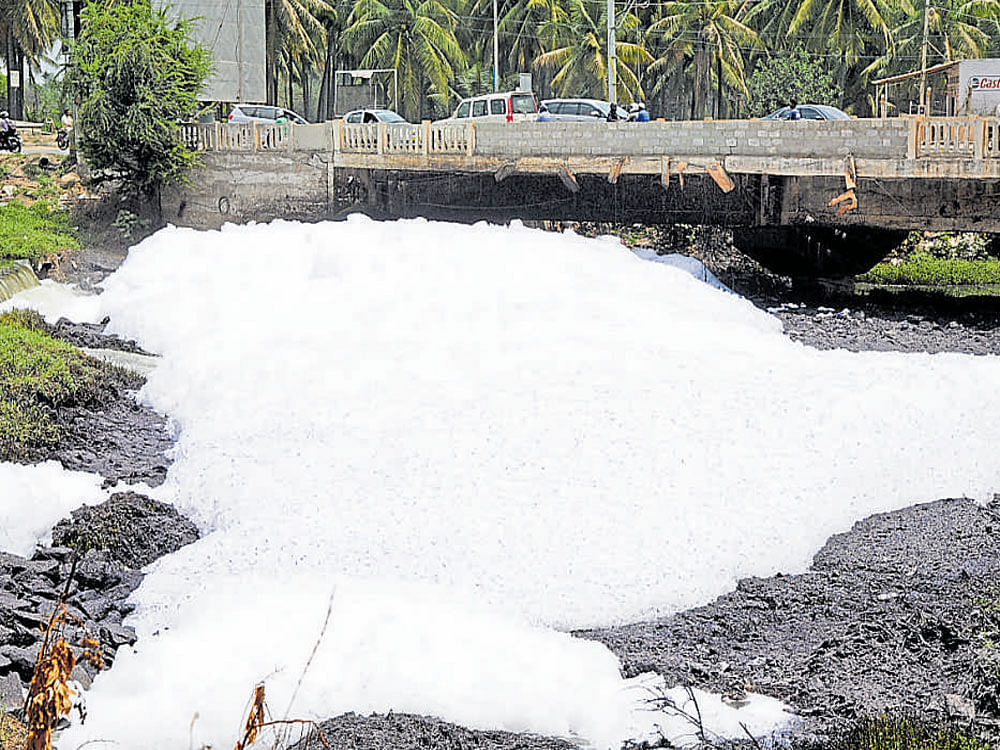'Detergent phosphates cause for frothing at lakes'Govt urged to replace phosphates with zeolites in detergents
Last Updated IST

High phosphate content in Varthur lake causes frothing, say researchers. DH PHOTO
Researchers from IISc have called upon the state and central governments to ban or limit the presence of phosphates in detergents and floor cleaners in the wake of the increasing frothing in Bellandur and Varthur lakes.
A recent study by a team of researchers from Energy and Wetlands Group, IISc, shows that the presence of phosphates and nitrates is leading to the frothing. Prof T V Ramachandra of the Group is the lead author of the research paper — Foaming or Algal Bloom in Water bodies of India: Remedial Measures-Restrict Phosphate (P) based Detergents — released this month. The study points out that algal bloom or frothing is a consequence of nutrient enrichment (nitrate and phosphate) due to untreated sewage (mostly from households and detergents) and causes pollution, leading to algal blooms. The study shows that phosphate content in Varthur lake goes up to 1.263 mg/litre in some places, which is high. The phosphate in the foam is 74.59 mg/l.
“Ideally, there should not be phosphate residue in water, even a small quantity is dangerous. But it is present in large quantities in Varthur lake. Initially, industrialists, people and ministers did not believe that the presence of phosphates and nitrates was leading to the frothing. We (researchers) explained to some companies and industrialists about the frothing and they accepted it,” he said. Apart from this, the government needs to increase the number of sewage treatment plants quickly to handle the untreated sewage entering the lake, he said.
Foreign models
Ramachandra said he was urging the government to follow the model of countries like Belgium, France, Germany, Hungary, Italy, Netherlands, Switzerland and the US, where they have switched from detergents containing phosphates to those containing zeolites.
A recent study by a team of researchers from Energy and Wetlands Group, IISc, shows that the presence of phosphates and nitrates is leading to the frothing. Prof T V Ramachandra of the Group is the lead author of the research paper — Foaming or Algal Bloom in Water bodies of India: Remedial Measures-Restrict Phosphate (P) based Detergents — released this month. The study points out that algal bloom or frothing is a consequence of nutrient enrichment (nitrate and phosphate) due to untreated sewage (mostly from households and detergents) and causes pollution, leading to algal blooms. The study shows that phosphate content in Varthur lake goes up to 1.263 mg/litre in some places, which is high. The phosphate in the foam is 74.59 mg/l.
“Ideally, there should not be phosphate residue in water, even a small quantity is dangerous. But it is present in large quantities in Varthur lake. Initially, industrialists, people and ministers did not believe that the presence of phosphates and nitrates was leading to the frothing. We (researchers) explained to some companies and industrialists about the frothing and they accepted it,” he said. Apart from this, the government needs to increase the number of sewage treatment plants quickly to handle the untreated sewage entering the lake, he said.
Foreign models
Ramachandra said he was urging the government to follow the model of countries like Belgium, France, Germany, Hungary, Italy, Netherlands, Switzerland and the US, where they have switched from detergents containing phosphates to those containing zeolites.